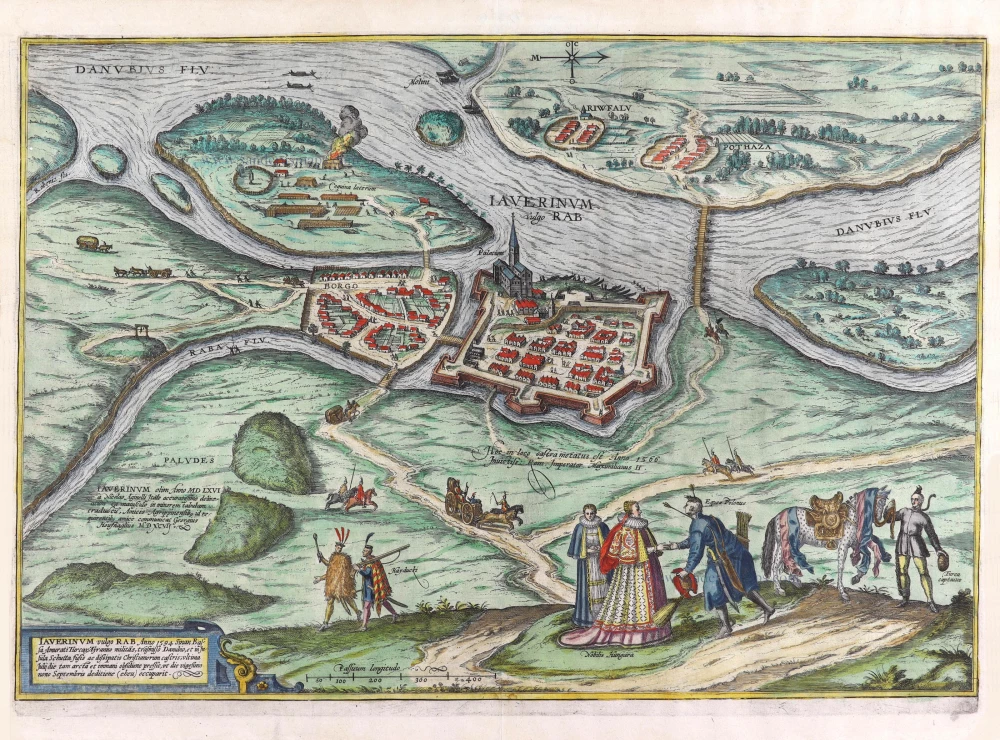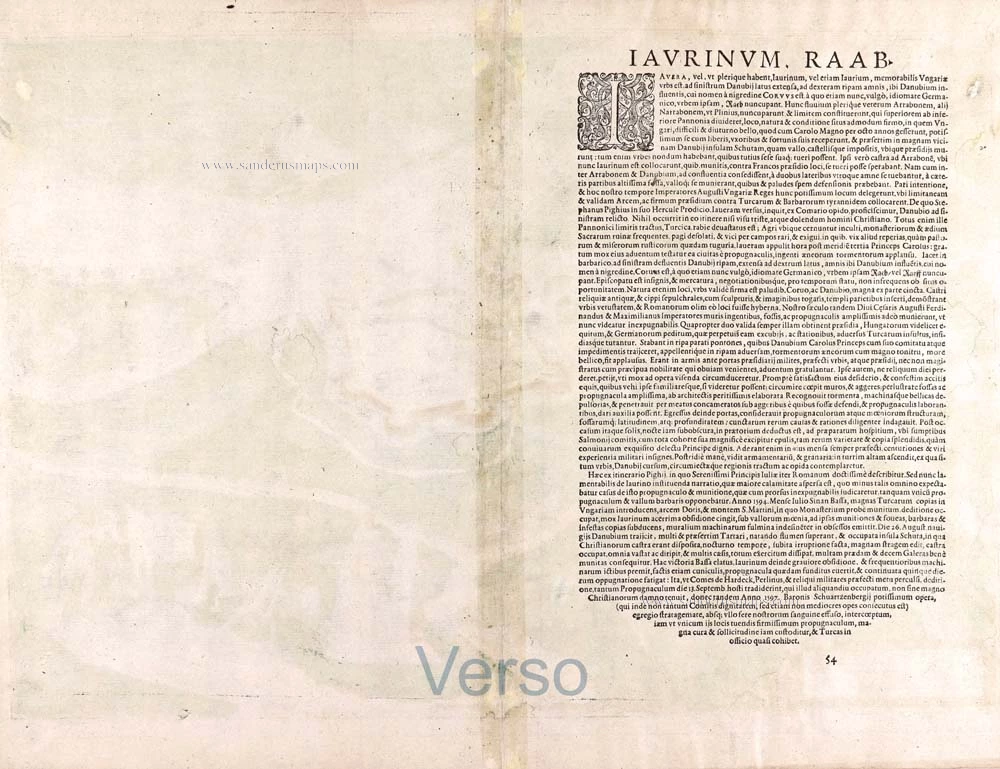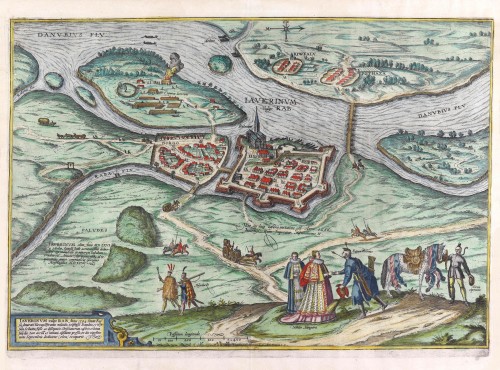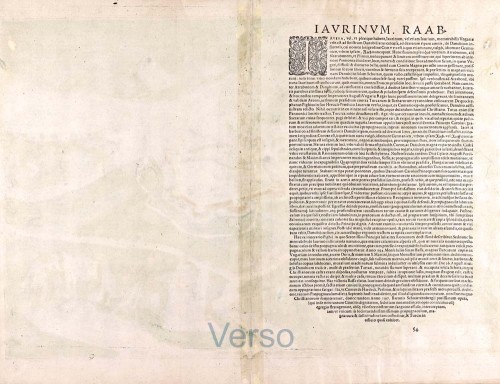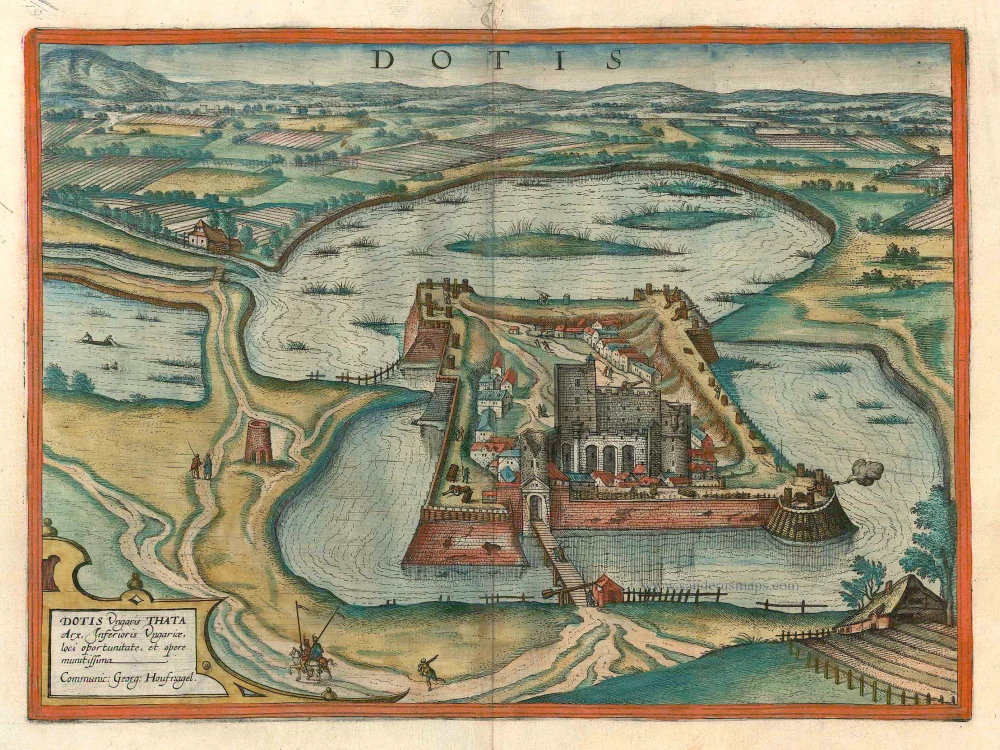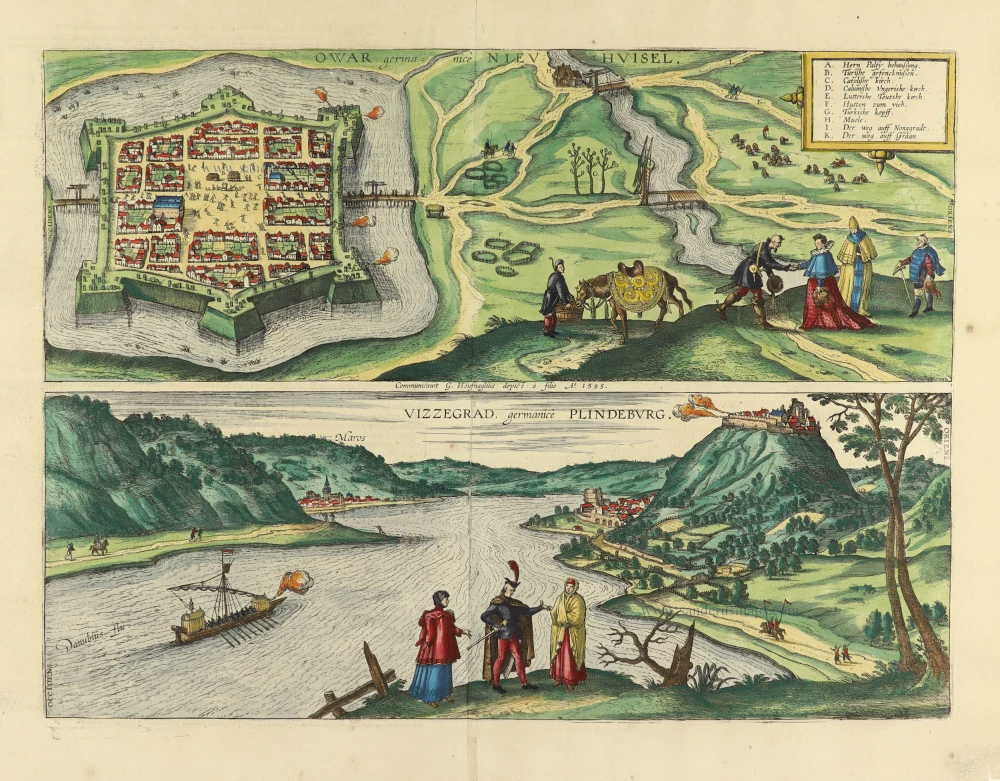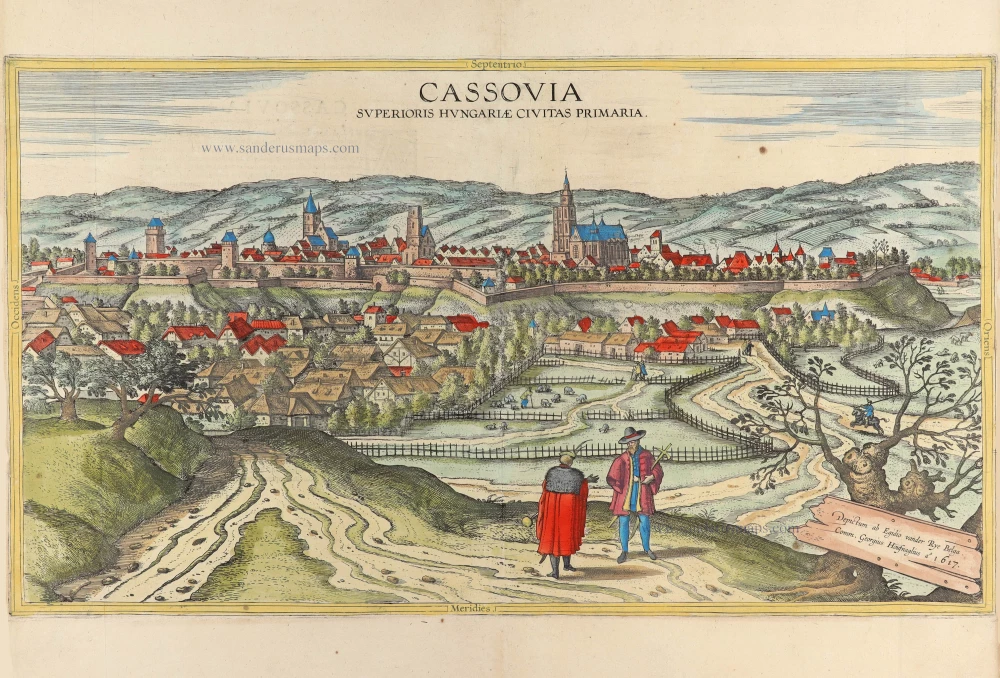Györ in Hungary by Braun and Hogenberg. 1617
TRANSLATION OF CARTOUCHE TEXT: Iaverinum, in German Raab. In the year 1594, Sinan Bassa, serving under the Turkish ruler Amurat, crossed the Danube, scattered the camp of the Christians on the Island of Schutta, and on 31 July began such an oppressive and terrible siege of the city that he was able to seize possession of it on 29 September.
SIGNED AND DATED BOTTOM LEFT: Iaverium, once drawn most accurately by the Italian Nicolas Aginelli in the year 1566, transferred from a somewhat larger to a smaller format, kindly provided by Georg Hoefnagel at the request of his friends in Cologne in the year 1597.
COMMENTARY BY BRAUN: "Györ is a well-known town in Hungary, on the left side of the Danube. On the right side flows the Rába, which empties into the Danube here. The town has an important bishopric and significant trade and industry because of its location. The remains of the old castle walls, the tombs and the carved and painted pictures on the churches' walls show the town's age and that the Romans formerly made their winter camp here and occupied the town. In our times, Emperors Ferdinand and Maximilian have fortified it with such thick walls, deep moats and mighty bastions that it is now quite impregnable."
Györ, which lies southeast of Bratislava at the confluence of the Raba and an arm of the Danube, is seen here in a bird's-eye view. Italian military engineers constructed the bastioned fortifications and the bishop's palace (Palatium) in the early 16th century. The palace lay near the Cathedral of Our Lady, which was built on the ruins of a Roman temple. When Buda fell to the Ottoman Empire in 1541, it heightened Györ's importance as the Habsburgs' easternmost bulwark. Under Turkish occupation (1594-1598), the town was almost destroyed and, for a while, bore the Turkish name of Yanik Kala ("burned mountain"). The captions refer to historical events, such as that in the centre: "Here the Roman Emperor Maximilian II marked out an impregnable camp in the year 1566". Györ's situation at the time of this engraving is underlined by the animated staffage figures, who are identified from left to right as follows: "Heyducks/ Hungarian noblewomen/Polish knight" [with arrows in his torso]/"Captive Turk". Over the 17th century, Györ slowly started to recover and was rebuilt in the 18th century. (Taschen)
Braun G. & Hogenberg F. and the Civitates Orbis Terrarum.
The Civitates Orbis Terrarum, also known as the 'Braun & Hogenberg', is a six-volume town atlas and the most excellent book of town views and plans ever published: 363 engravings, sometimes beautifully coloured. It was one of the best-selling works in the last quarter of the 16th century. Georg Braun, a skilled writer, wrote the text accompanying the plans and views on the verso. Many plates were engraved after the original drawings of a professional artist, Joris Hoefnagel (1542-1600). The first volume was published in Latin in 1572 and the sixth in 1617. Frans Hogenberg, a talented engraver, created the tables for volumes I through IV, and Simon van den Neuwel made those for volumes V and VI. Other contributors were cartographers Daniel Freese and Heinrich Rantzau, who provided valuable geographical information. Works by Jacob van Deventer, Sebastian Münster, and Johannes Stumpf were also used as references. Translations appeared in German and French, making the atlas accessible to a broader audience.
Since its original publication of volume 1 in 1572, the Civitates Orbis Terrarum has left an indelible mark on the history of cartography. Seven more editions followed the first volume in 1575, 1577, 1582, 1588, 1593, 1599, and 1612. Vol.2, initially released in 1575, saw subsequent editions in 1597 and 1612. The subsequent volumes, each a treasure trove of historical insights, graced the world in 1581, 1588, 1593, 1599, and 1606. The German translation of the first volume, a testament to its widespread appeal, debuted in 1574, followed by the French edition in 1575.
Several printers were involved: Theodor Graminaeus, Heinrich von Aich, Gottfried von Kempen, Johannis Sinniger, Bertram Buchholtz, and Peter von Brachel, all of whom worked in Cologne.
Georg Braun (1541-1622)
Georg Braun, the author of the text accompanying the plans and views in the Civitates Orbis Terrarum, was born in Cologne in 1541. After his studies in Cologne, he entered the Jesuit Order as a novice, indicating his commitment to learning and intellectual pursuits. In 1561, he obtained his bachelor's degree; in 1562, he received his Magister Artium, further demonstrating his academic achievements. Although he left the Jesuit Order, he continued his studies in theology, gaining a licentiate in theology. His theological background likely influenced the content and tone of the text in the Civitates Orbis Terrarum, adding a unique perspective to the work.
Frans Hogenberg (1535-1590)
Frans Hogenberg was a Flemish and German painter, engraver, and mapmaker. He was born in Mechelen as the son of Nicolaas Hogenberg.
By the end of the 1560s, Frans Hogenberg was employed upon Abraham Ortelius's Theatrum Orbis Terrarum, published in 1570; he is named an engraver of numerous maps. In 1568, he was banned from Antwerp by the Duke of Alva and travelled to London, where he stayed a few years before emigrating to Cologne. He immediately embarked on his two most important works, the Civitates, published in 1572 and the Geschichtsblätter, which appeared in several series from 1569 until about 1587.
Thanks to large-scale projects like the Geschichtsblätter and the Civitates, Hogenberg's social circumstances improved with each passing year. He died as a wealthy man in Cologne in 1590.
Iaverinum vulgo Rab.
Item Number: 29854 Authenticity Guarantee
Category: Antique maps > Europe > Central Europe
Old, antique bird’s-eye view plan of Györ in Hungary by Braun and Hogenberg.
Title: Iaverinum vulgo Rab.
Iaverinum olim Anno MDLXVI a Nicolao Aginelli Italo accuratissime delineatum in maiusculo in minorem tabulam traductum, Amicis Agrippinensib, id requirentib, amicè communicat Georgius Houfnaglius MDXCVII.
Descriptive text: Iaverinum Vulgo Rab Anno 1594 Sinan Bassa Amurati Turcar. ...
Designer: Georg Hoefnagel.
Date of the first edition: 1596.
Date of this map: 1617.
Copper engraving, printed on paper.
Image size: 360 x 510mm (14.17 x 20.08 inches).
Sheet size: 405 x 530mm (15.94 x 20.87 inches).
Verso: Latin text.
Condition: Original coloured, excellent.
Condition Rating: A+.
From: G. Braun & F. Hogenberg. Civitates Orbis Terrarum. - Urbium Praecipuarum Mundi Theatrum Quintum. Cologne, Petrus von Brachel, 1617. (Van der Krogt 41:1.5 (1617)).
TRANSLATION OF CARTOUCHE TEXT: Iaverinum, in German Raab. In the year 1594, Sinan Bassa, serving under the Turkish ruler Amurat, crossed the Danube, scattered the camp of the Christians on the Island of Schutta, and on 31 July began such an oppressive and terrible siege of the city that he was able to seize possession of it on 29 September.
SIGNED AND DATED BOTTOM LEFT: Iaverium, once drawn most accurately by the Italian Nicolas Aginelli in the year 1566, transferred from a somewhat larger to a smaller format, kindly provided by Georg Hoefnagel at the request of his friends in Cologne in the year 1597.
COMMENTARY BY BRAUN: "Györ is a well-known town in Hungary, on the left side of the Danube. On the right side flows the Rába, which empties into the Danube here. The town has an important bishopric and significant trade and industry because of its location. The remains of the old castle walls, the tombs and the carved and painted pictures on the churches' walls show the town's age and that the Romans formerly made their winter camp here and occupied the town. In our times, Emperors Ferdinand and Maximilian have fortified it with such thick walls, deep moats and mighty bastions that it is now quite impregnable."
Györ, which lies southeast of Bratislava at the confluence of the Raba and an arm of the Danube, is seen here in a bird's-eye view. Italian military engineers constructed the bastioned fortifications and the bishop's palace (Palatium) in the early 16th century. The palace lay near the Cathedral of Our Lady, which was built on the ruins of a Roman temple. When Buda fell to the Ottoman Empire in 1541, it heightened Györ's importance as the Habsburgs' easternmost bulwark. Under Turkish occupation (1594-1598), the town was almost destroyed and, for a while, bore the Turkish name of Yanik Kala ("burned mountain"). The captions refer to historical events, such as that in the centre: "Here the Roman Emperor Maximilian II marked out an impregnable camp in the year 1566". Györ's situation at the time of this engraving is underlined by the animated staffage figures, who are identified from left to right as follows: "Heyducks/ Hungarian noblewomen/Polish knight" [with arrows in his torso]/"Captive Turk". Over the 17th century, Györ slowly started to recover and was rebuilt in the 18th century. (Taschen)
Braun G. & Hogenberg F. and the Civitates Orbis Terrarum.
The Civitates Orbis Terrarum, also known as the 'Braun & Hogenberg', is a six-volume town atlas and the most excellent book of town views and plans ever published: 363 engravings, sometimes beautifully coloured. It was one of the best-selling works in the last quarter of the 16th century. Georg Braun, a skilled writer, wrote the text accompanying the plans and views on the verso. Many plates were engraved after the original drawings of a professional artist, Joris Hoefnagel (1542-1600). The first volume was published in Latin in 1572 and the sixth in 1617. Frans Hogenberg, a talented engraver, created the tables for volumes I through IV, and Simon van den Neuwel made those for volumes V and VI. Other contributors were cartographers Daniel Freese and Heinrich Rantzau, who provided valuable geographical information. Works by Jacob van Deventer, Sebastian Münster, and Johannes Stumpf were also used as references. Translations appeared in German and French, making the atlas accessible to a broader audience.
Since its original publication of volume 1 in 1572, the Civitates Orbis Terrarum has left an indelible mark on the history of cartography. Seven more editions followed the first volume in 1575, 1577, 1582, 1588, 1593, 1599, and 1612. Vol.2, initially released in 1575, saw subsequent editions in 1597 and 1612. The subsequent volumes, each a treasure trove of historical insights, graced the world in 1581, 1588, 1593, 1599, and 1606. The German translation of the first volume, a testament to its widespread appeal, debuted in 1574, followed by the French edition in 1575.
Several printers were involved: Theodor Graminaeus, Heinrich von Aich, Gottfried von Kempen, Johannis Sinniger, Bertram Buchholtz, and Peter von Brachel, all of whom worked in Cologne.
Georg Braun (1541-1622)
Georg Braun, the author of the text accompanying the plans and views in the Civitates Orbis Terrarum, was born in Cologne in 1541. After his studies in Cologne, he entered the Jesuit Order as a novice, indicating his commitment to learning and intellectual pursuits. In 1561, he obtained his bachelor's degree; in 1562, he received his Magister Artium, further demonstrating his academic achievements. Although he left the Jesuit Order, he continued his studies in theology, gaining a licentiate in theology. His theological background likely influenced the content and tone of the text in the Civitates Orbis Terrarum, adding a unique perspective to the work.
Frans Hogenberg (1535-1590)
Frans Hogenberg was a Flemish and German painter, engraver, and mapmaker. He was born in Mechelen as the son of Nicolaas Hogenberg.
By the end of the 1560s, Frans Hogenberg was employed upon Abraham Ortelius's Theatrum Orbis Terrarum, published in 1570; he is named an engraver of numerous maps. In 1568, he was banned from Antwerp by the Duke of Alva and travelled to London, where he stayed a few years before emigrating to Cologne. He immediately embarked on his two most important works, the Civitates, published in 1572 and the Geschichtsblätter, which appeared in several series from 1569 until about 1587.
Thanks to large-scale projects like the Geschichtsblätter and the Civitates, Hogenberg's social circumstances improved with each passing year. He died as a wealthy man in Cologne in 1590.

